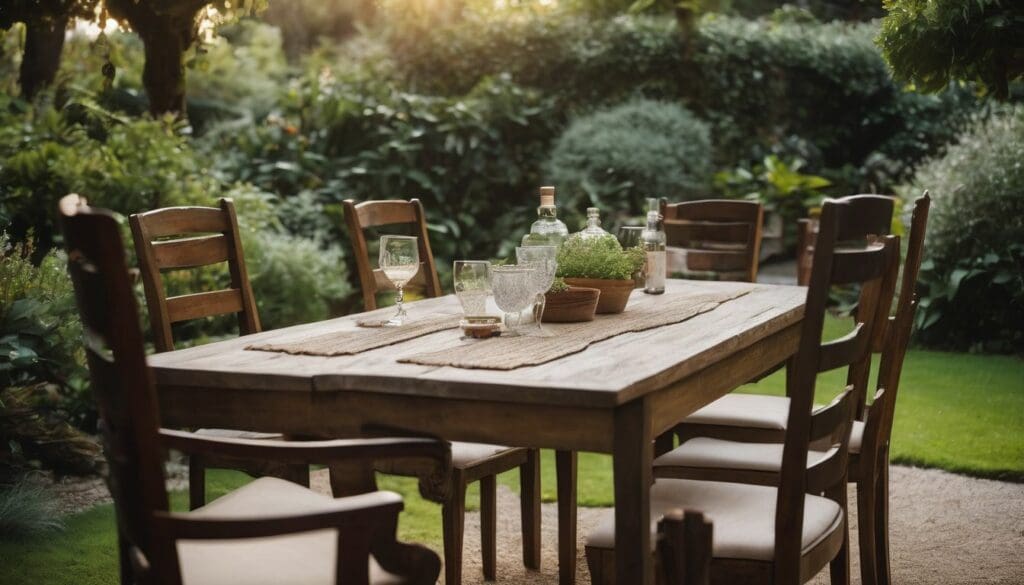Kitting out your abode in an eco-conscious fashion is quickly becoming the name of the game – and it’s a game we’re well and truly invested in. Like you, we’ve grappled with marrying chic design with environmental responsibility within our own four walls.
Our forthcoming article delves deep into the realm of sustainable furnishings and décor, brimming with savvy advice for curating a home that’s as gentle on our dear Earth as it is aesthetically pleasing.
Let us spark your imagination and guide you through a green transformation of your personal sanctuary!
Key Takeaways
- Eco – friendly furniture is crafted from sustainable materials like reclaimed wood, bamboo, and recycled metal, reducing environmental harm and supporting fair labour practices.
- Choosing items made from renewable resources such as biodegradable fabrics or mycelium-based products lowers our carbon footprint and aids in waste reduction.
- Sustainable materials enhance home aesthetics while promoting a green lifestyle; innovations like 3D printed furniture allow for customisation with minimal waste.
- Integrating eco-friendly design in home decor includes using bold colours with natural finishes, built-in furniture of local materials, vintage pieces, bioclimatic architecture principles and BIM technology for virtual construction planning.
- The future trends indicate growing consumer demand for sustainable home decor options driven by advancements in ethical production methods and the spread of awareness about eco-conscious living.
Eco-Friendly Furniture: What Does It Mean?
We choose materials that give back to the planet when we craft eco-friendly furniture. Think reclaimed wood, bamboo, and recycled metal—these are all renewable or waste-reducing options that cut down on environmental harm.
Furniture like this isn’t just about using green materials, though. It’s also about production processes that conserve energy and water, creating fewer pollutants.
Crafting these pieces often involves ethical labour practices too. We support communities and ensure fair wages for the skilled hands making our sustainable home furnishings. Ecoconscious home decor goes beyond looks; it carries a story of environmental stewardship and social responsibility.
Now let’s take a closer look at how choosing eco-friendly furniture benefits our world in the next section.
The Benefits of Choosing Eco-Friendly Furniture
Choosing eco-friendly furniture means using sustainable materials, reducing your carbon footprint, and positively impacting the environment. It also means supporting ethical and environmentally-conscious brands that are committed to making a difference in the world.
Sustainable materials
Eco-friendly furniture and home decor are made using sustainable materials such as reclaimed wood, biodegradable fabrics, and mycelium-based products. These materials are environmentally friendly and help to reduce the carbon footprint associated with production.
By choosing eco-friendly furnishings made from renewable resources, we can support ethical brands that prioritise sustainability in their manufacturing processes. Utilising these sustainable materials also positively impacts the environment by reducing waste and natural resource depletion while promoting a green lifestyle.
Incorporating sustainable materials into furniture and home decor not only contributes to a healthier planet but also creates stylish and functional living spaces in alignment with our values of environmental conservation.
Reduced carbon footprint
Using sustainable materials such as reclaimed wood and biodegradable substances significantly diminishes the carbon footprint of eco-friendly furniture. These options have a lower impact on the environment as they often require less energy to produce, emitting fewer greenhouse gases into the atmosphere.
Choosing eco-friendly furnishings made from renewable or upcycled materials promotes a healthier planet by reducing the need for excessive resource extraction and cutting down on waste in landfills.
Additionally, opting for innovative production methods like 3D printing further contributes to minimising carbon emissions typically associated with traditional manufacturing processes.
Positive impact on the environment
Choosing eco-friendly furniture and home decor has a positive impact on the environment. By opting for sustainable materials like reclaimed wood and biodegradable products, we contribute to reducing deforestation and minimising waste in landfills.
Additionally, supporting ethical and environmentally-conscious brands encourages responsible manufacturing practices, helping to lower carbon emissions. These choices promote a greener planet by conserving natural resources and promoting ecological balance.
Incorporating eco-friendly design in our homes not only enhances aesthetics but also reduces our carbon footprint. Utilising renewable materials in furniture and upcycled home furnishings minimises the need for new resources, contributing to sustainable living.
Supporting ethical and environmentally-conscious brands
Choosing eco-friendly furniture and home decor not only has a positive impact on the environment but also supports ethical and environmentally-conscious brands. By opting for sustainable materials and products, you actively contribute to the preservation of natural resources and reduce your carbon footprint in a tangible way.
It’s essential to align with brands that have strong ethical commitments and prioritise environmentally-friendly production processes, ensuring that your choices make a meaningful difference.
As consumers, we hold the power to drive change by consciously supporting companies that share our values of sustainability and conservation.
Innovative materials offer exciting opportunities for designers to create stylish yet eco-friendly furnishings. These forward-thinking designs promote environmental responsibility while enhancing your living space with quality, ethically-produced items.
Sustainable and Innovative Materials Used in Eco-Friendly Furniture
From biodegradable materials to 3D printed furniture, the world of eco-friendly furniture is constantly evolving with innovative and sustainable materials. These materials not only reduce environmental impact but also offer unique and modern designs for your home.
Biodegradable materials
Biodegradable materials play a pivotal role in eco-friendly furniture and home decor. These materials break down naturally, contributing to a circular economy by reducing waste and minimising environmental impact.
Incorporating biodegradable elements such as natural fibres, organic cotton, hemp, bamboo, and cork into home furnishings ensures that they can decompose without harming the environment.
This not only fosters sustainable living but also supports ethical brands committed to conservation efforts.
Mycelium-based products are gaining traction within the eco-friendly furniture market. The use of mycelium, the root structure of mushrooms, allows for innovative and sustainable designs that are both biodegradable and compostable.
Compostable furnishings
Compostable furnishings are a sustainable option for environmentally conscious individuals. These furnishings are made from organic materials that can be broken down and returned to the earth, minimising waste and reducing environmental impact.
By choosing compostable furnishings, we actively contribute to creating a circular economy and promoting eco-friendly practices within our homes.
Incorporating compostable furnishings into our living spaces not only showcases our commitment to sustainability but also sets an example for others to follow. The use of natural and eco-friendly home accessories like compostable furniture is crucial in supporting conservation efforts and creating healthier living environments for present and future generations.
As we embrace the concept of compostable furnishings, we pave the way for a greener, more sustainable future where ethical interior design choices become the norm.
Mycelium-based products
Mycelium-based products offer a sustainable and innovative alternative to traditional materials. Mycelium, the root structure of mushrooms, can be grown into various shapes and forms to create furniture, decor items, and even building materials.
These products are not only biodegradable but also have minimal environmental impact during production. With their ability to be shaped into diverse designs and structures, mycelium-based products present an exciting opportunity for environmentally conscious individuals looking to incorporate sustainable alternatives into their homes.
Moving on from mycelium-based products, let’s explore the use of reclaimed wood in eco-friendly furniture and home decor.
Reclaimed wood
Transitioning from innovative mycelium-based products to the eco-friendly material of reclaimed wood, we find an excellent example of sustainable and ethical furniture production. Reclaimed wood refers to timber salvaged from old buildings, barns, or other structures slated for demolition.
The process involves repurposing this discarded timber into stylish and eco-conscious furniture pieces, minimising waste and reducing the demand for new raw materials. This practice not only contributes to a reduction in deforestation but also adds character and history to the final product.
Additionally, choosing reclaimed wood supports ethical and environmentally-conscious brands that prioritise sustainable sourcing methods while creating unique, timeless pieces for your home decor.
The beauty of reclaimed wood lies not just in its ecological benefits but also in the individuality it brings to any space. Each piece tells a story through its natural imperfections, preserving the heritage of the original structure it came from while adding warmth and authenticity to modern interiors.
3D printed furniture
3D printed furniture introduces innovative sustainable production methods, using materials such as bioplastics and recycled filaments to create unique, customised pieces. This eco-friendly approach minimises waste and energy consumption, offering environmentally conscious individuals an opportunity to invest in furniture that aligns with their values.
Furthermore, 3D printing allows for intricate designs and shapes that were previously impossible or costly to produce through traditional manufacturing methods.
As the demand for sustainable home furnishings continues to grow, 3D printed furniture is set to revolutionise the industry by offering personalised, environmentally friendly options that cater to individual tastes and needs.
With advancements in material technology and design capabilities, 3D printing presents a promising future for eco-friendly interior decor.
Incorporating Eco-Friendly Design in Home Decor
Integrating eco-friendly design in home decor involves using bold hues and natural finishes, incorporating built-in furniture, choosing vintage and second-hand items, embracing bioclimatic architecture, and exploring virtual design with Building Information Modelling (BIM).
These innovative approaches to interior design not only enhance the aesthetic appeal of homes but also promote sustainability and environmental consciousness.
Bold hues and natural finishes
Bold hues and natural finishes are excellent ways to incorporate eco-friendly design into home decor. Choosing paint colours, textiles, and furniture with vibrant earth tones, such as forest green and terracotta, can add a touch of nature-inspired beauty while reducing the need for synthetic dyes.
Opting for natural finishes on furniture, such as untreated wood or plant-based oils, contributes to a healthier indoor environment without compromising style.
Incorporating bold hues and natural finishes not only enhances the aesthetic appeal of your living space but also aligns with sustainable principles. By choosing these elements in our home decor choices, we contribute to a more environmentally conscious lifestyle that supports conservation efforts while promoting ethical and eco-friendly design practices.
Built-in furniture
When designing a sustainable home, incorporating built-in furniture can be an eco-friendly and space-saving solution. Utilising locally-sourced and natural materials in the construction of built-in furniture reduces the carbon footprint associated with shipping and manufacturing.
It also eliminates the need for disposable furniture that adds to landfill waste. Integrating built-in furniture seamlessly into the design of your home contributes to a cleaner, more minimalist aesthetic, which is both stylish and environmentally conscious.
Incorporating built-in furniture not only provides a versatile storage solution but also ensures longevity due to its sturdy nature. This type of design reduces the consumption of mass-produced, disposable pieces and encourages making use of existing space efficiently.
Vintage and second-hand items
When considering eco-friendly design in home décor, incorporating vintage and second-hand items can significantly reduce the demand for new production and minimise waste. Choosing pre-loved pieces not only adds character to your living space but also contributes to a more sustainable lifestyle.
By repurposing existing items, we actively participate in the circular economy, reducing our environmental impact while supporting ethical consumer choices. Vintage and second-hand items offer unique styles that stand out as timeless classics, allowing us to create a green living space without compromising on personal taste.
Moving forward to “Bioclimatic architecture,” let’s explore how sustainable design integrates with architectural principles for environmentally conscious homes.
Bioclimatic architecture
Bioclimatic architecture considers the local climate and environment to design homes that are energy-efficient and sustainable. By strategically using natural elements like sunlight, wind, and vegetation for heating, cooling, and lighting, bioclimatic homes reduce the need for artificial energy sources.
This eco-friendly approach not only minimises environmental impact but also promotes healthier living spaces for occupants. Incorporating bioclimatic principles into home design can lead to reduced energy consumption, lower utility bills, and a smaller carbon footprint.
Incorporating bioclimatic architecture in home design creates comfortable living spaces while reducing environmental impact. This sustainable approach utilises natural elements to decrease reliance on artificial energy sources while promoting healthy indoor environments.
Virtual design and construction with BIM
Virtual design and construction with BIM enables us to create eco-friendly homes by optimising resource efficiency, reducing waste, and minimising environmental impact. By using Building Information Modelling (BIM), we can visualise the entire construction process virtually, allowing for sustainable material choices, streamlined logistics, and improved energy performance.
This approach empowers us to make informed decisions about eco-friendly finishes and furnishings right from the planning stage through to completion, ensuring that our homes are not only stylish but also environmentally conscious.
Implementing virtual design and construction with BIM fosters a collaborative environment where architects, engineers, and designers can work together seamlessly to integrate sustainable building practices.
By digitally simulating different scenarios before breaking ground on a project, we can enhance the overall eco-friendliness of our living spaces while achieving aesthetically pleasing designs.
The Future of Eco-Friendly Homes and Consumer Choices
As consumers become more environmentally conscious, the demand for sustainable products is expected to increase. Technological advancements in production and certification processes will play a vital role in meeting this demand.
Additionally, educating consumers about making sustainable choices and the impact of misleading “environmentally friendly” claims will be crucial for the growth of the sustainable home decor market.
Technological advancements for sustainable production
Innovative technologies are revolutionising sustainable furniture and home decor production, paving the way for eco-friendly options that are both stylish and environmentally responsible.
Manufacturers are harnessing advanced 3D printing techniques to create furniture from recycled materials, reducing waste and energy consumption in the process. Additionally, sophisticated software such as Building Information Modelling (BIM) is being used to design homes with an emphasis on sustainability, optimising energy use and promoting eco-friendly living spaces.
As environmentally conscious individuals seeking sustainable choices for home furnishings, it’s essential to stay informed about these technological advancements shaping the market.
Embracing these innovations will not only contribute to greener lifestyles but also support a burgeoning industry focused on ethical and eco-conscious practices.
Certified eco-friendly products
– Technological advancements for sustainable production pave the way for a significant aspect of the future of eco-friendly homes and consumer choices – certified eco-friendly products.
As environmentally conscious individuals, it’s essential to look out for certifications from recognised organisations such as Forest Stewardship Council (FSC), Global Organic Textile Standard (GOTS), and Cradle to Cradle CertifiedTM when choosing furniture and home decor.
These certifications ensure that the products meet strict environmental, social, and economic standards, giving you peace of mind that your purchases are truly eco-friendly.
Educating consumers on making sustainable choices
We can empower consumers by providing clear information on sustainable choices. This includes transparent labelling and certification for eco-friendly products, helping individuals make informed decisions.
By promoting awareness about the environmental impact of their choices, consumers can cultivate a mindset that values sustainability in furniture and home decor purchases.
Fostering an understanding of the materials used in products is crucial for making sustainable choices. This includes knowledge about biodegradable, compostable, and reclaimed materials, as well as innovative production methods such as 3D printing.
Impact of misleading “environmentally friendly” claims
Consumers need accurate information to make truly eco-friendly choices. Misleading claims can result in unknowingly supporting products that harm the environment through greenwashing, which is when brands overstate their sustainability efforts.
This practice undermines genuine environmentally friendly options and misleads customers who genuinely want to make ethical purchases. As a result, it’s crucial for consumers to stay vigilant and educate themselves about what makes a product truly sustainable and environmentally friendly.
Moving forward with our discussion of consumer choices, let’s explore the growth of the sustainable home decor market.
Growth of sustainable home decor market.
As environmentally conscious individuals, we have witnessed a significant increase in the sustainable home decor market. This growth is driven by our collective desire to make eco-friendly choices and support conservation efforts.
Green furniture decor, natural home accessories, ecofriendly finishes, and green living furnishings are becoming more popular as consumers seek out environmentally friendly design options for their homes.
The rise of the sustainable home decor market reflects our commitment to making ethical and environmentally conscious purchasing decisions. As we continue to educate ourselves on the benefits of choosing eco-friendly interior design, this market is expected to expand further.
Conclusion
Eco-friendly furniture and home decor are becoming increasingly popular among environmentally conscious individuals. Sustainable materials, innovative design, and a focus on reducing environmental impact are driving the market growth.
Consumers are making informed choices to support ethical and environmentally-conscious brands, shaping the future of eco-friendly homes and consumer preferences. The rise of eco-friendly furniture and home decor reflects a growing awareness of the importance of sustainable living in today’s society.
FAQs
1. What is the rise of eco-friendly furniture and home decor all about?
The rise of eco-friendly furniture and home decor shows increased market growth as more people choose furnishings that are good for the environment.
2. Why should someone consider ecofriendly interior design?
Opting for ecofriendly interior design means using natural and eco-friendly home furnishings, which helps reduce environmental impact while creating a stylish space.
3. What are some examples of green home decor?
Examples of green home decor include items like recycled glass vases, floor coverings made from sustainable materials, and furniture crafted from reclaimed wood.
4. Is it just about looks or does eco-conscious furnishings offer more?
Eco-conscious furnishings offer both style with their ‘ecochic’ look and practical benefits by being durable and helping to create a healthier living space.





